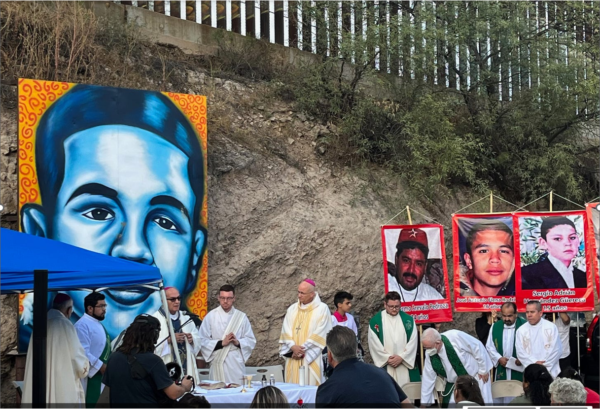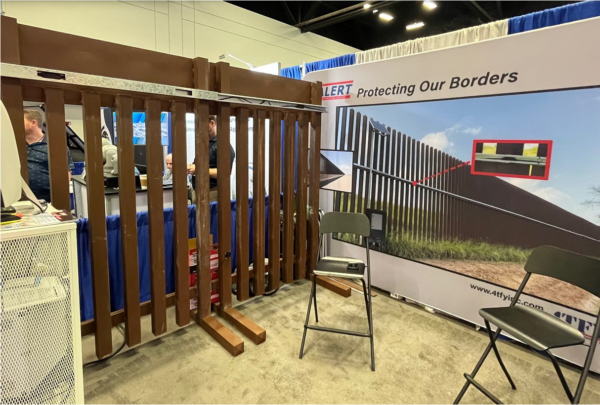
In this on-the-ground letter from the border, we explore how between Arizona and Sonora the razor tech barrier is–and likely will continue to be–a monument to many presidents and policies.
By Todd Miller (Border Chronicle)
HAVANA TIMES – Several rows of coiled razor wire drape the U.S.-Mexico border wall in Nogales, Arizona. The Trump administration put them there in 2018. Later, when Biden took office, the mayor of Nogales asked him to take the razor wire down—besides being visually and emotionally abrasive, it was dangerous, especially for children.
But the sharp coils remained. Recently, I stood in front of the wall with a group of around 30 teachers, looking at the wire sagging in disrepair, its barbs holding bits and pieces of clothing, presumably from the occasional person who tries to scale it (most do not). The teachers and I were there to talk about the history of the border wall, and how it became what it is today. While it may be fashionable to think that the border wall began with Trump, the wall is actually a monument to many presidents. Standing in front of it, you can see layers of history that go back more than three decades, some associated with individual presidential administrations, some blurring across partisan lines.
It was just over two weeks before the 2024 elections, and I was excited to be in Nogales with educators from all over the United States and the world to talk about inserting border analysis into their curriculum. Meanwhile, the campaigns raging along in the background continued to distort the border. Nogales, Arizona, and Nogales, Sonora, are really one city, with shared families, geographies, and circumstances divided by a political line. But the unnuanced, uncontextualized portrayals of the border that dominate election season rarely reflect this reality.
This is the third presidential race in a row in which the border has become a central villain. If you watch television in Arizona, the endless campaign commercials come across like horror movies, laden with grainy images of border walls, depicting the people who cross the border as criminal. Kamala Harris’ ads say that Donald Trump is not serious on the border, and that she—a former prosecutor—will be. She says she’ll work to pass a bipartisan, enforcement-heavy border bill (rejected earlier this year by the Republicans at the behest of Trump). She’ll hire more Border Patrol agents, build more wall, and bring in more technology.
On the other side, Trump continues to be Trump. He’s promised mass deportations of 15 to 20 million people. He mentions the border as much as possible on the campaign trail, painting it as a place of chaos and violence. He repeats deeply eugenicist remarks about immigrants “poisoning the blood of our country.”

Contemplating Trump’s rhetoric decrying U.S. “open borders” while in the shadow of the wall is absurd. Up the hill from where I stood with the teachers, a tall post holding several cameras—a remote video surveillance system, in official parlance—stares along the international boundary and into Mexico. I’ve been coming to this border —an hour away from my home in Tucson, Arizona— for 30 years, and these cameras have been here the entire time. Underneath them, Border Patrol agents watch the boundary line, unmoving during eight-hour shifts. This three-pronged logic of border enforcement dates back to the 1990s Clinton administration: barrier, armed agents, and technology.
While Trump campaigned in 2016 as if there were no wall, its construction here began in 1995, when I arrived at the Nogales border for the first time. That year the government replaced chain-link fences with a 15-foot wall of rusty-looking metal once used as makeshift landing strips during the Vietnam and Persian Gulf Wars. They were the blueprints for a new strategy, still in place today: prevention through deterrence. Block off the traditional crossing routes in the border cities, and the surrounding deserts would be potentially “mortal,” a 1994 Border Patrol memorandum explained. It was a prophecy: At least 10,000 people have died crossing the border since then.
During the Clinton era, border and immigration enforcement budgets nearly tripled—from roughly $1.5 billion to over $4.2 billion in 2000. Then came 9/11. In its aftermath, the George W. Bush administration brought enforcement to unseen levels, converting the border into another flank in the War on Terror.

At the time, I crossed the border several times a week for work, and I watched it transform and deform before my very eyes. The days when Cinco de Mayo and Mexican Independence Day parades crisscrossed the boundary line were long over. By the end of the Bush administration in 2008, the annual combined U.S. Customs and Border Protection (CBP) and Immigration and Customs Enforcement (ICE) budget ascended to $14.4 billion, the most money put into the border under a single president. This investment spurred the largest hiring surge in Border Patrol history—8,000 new agents in three years. Meanwhile, the government awarded a nearly $2 billion contract to the Boeing Corporation to use technology to construct a virtual wall, and Congress funded the construction of more physical barriers through the 2006 Secure Fence Act (passed with yes votes by future Democratic presidents and presidential candidates Joe Biden, Barack Obama, and Hillary Clinton).
In 2011, during the Obama administration, I watched the machinery from the Secure Fence Act arrive in Nogales—easily removing the original landing-mat wall as if it were plucking out a set of bad teeth. Thick steel bars resembling that of a prison cell replaced the rusty metal sheets. Shortly after, in 2012, a Border Patrol agent shot and killed an unarmed 16-year-old-boy through those bars. As the teachers and I walk up the hill —past the agent, past the surveillance tower— we find artificial flowers on the border wall honoring José Antonio Elena Rodríguez, and when we looked down into Nogales, Sonora, a small cross and altar. Ten bullets hit José Antonio in the back and head as he walked on the Mexican side of the wall; Border Patrol claimed he was throwing rocks.
While the Biden administration ignored Nogales’ mayor’s request to take down the coiling razor wire in 2021, earlier this year—for a moment—it seemed something had changed. CBP removed the razor wire from a large swath of wall. Observers speculated that the wire might finally come down. But when I called CBP to figure out what was going on, an information officer told me that wasn’t the case. They were only taking it down to put up what he called a new “capability.”

I pointed to the section where the wire had been replaced with metal casing and black cable out to the teachers. CBP hasn’t made much more information public, but in May, I went to El Paso for the Border Security Expo, an annual event that brings together top brass from CBP and ICE with private industry. There, I talked with representatives of a company whose product looked exactly what I had seen stretched along the top of the Nogales border wall. It was a sensor system—a “smart” wall. It can detect if a person is touching the wall, or “sawing through it,” the vendor told me. At the expo, I felt as though I was glimpsing what the next 30 years of border enforcement may look like, especially the future technological layers to be added to the wall. While the two parties have distinct positions and rhetoric on the border, it’s clear that they’ll move, as their predecessors have, in the same direction. It may become something out of science fiction, but the razor wire is here to stay.
Read more feature articles here on Havana Times.




